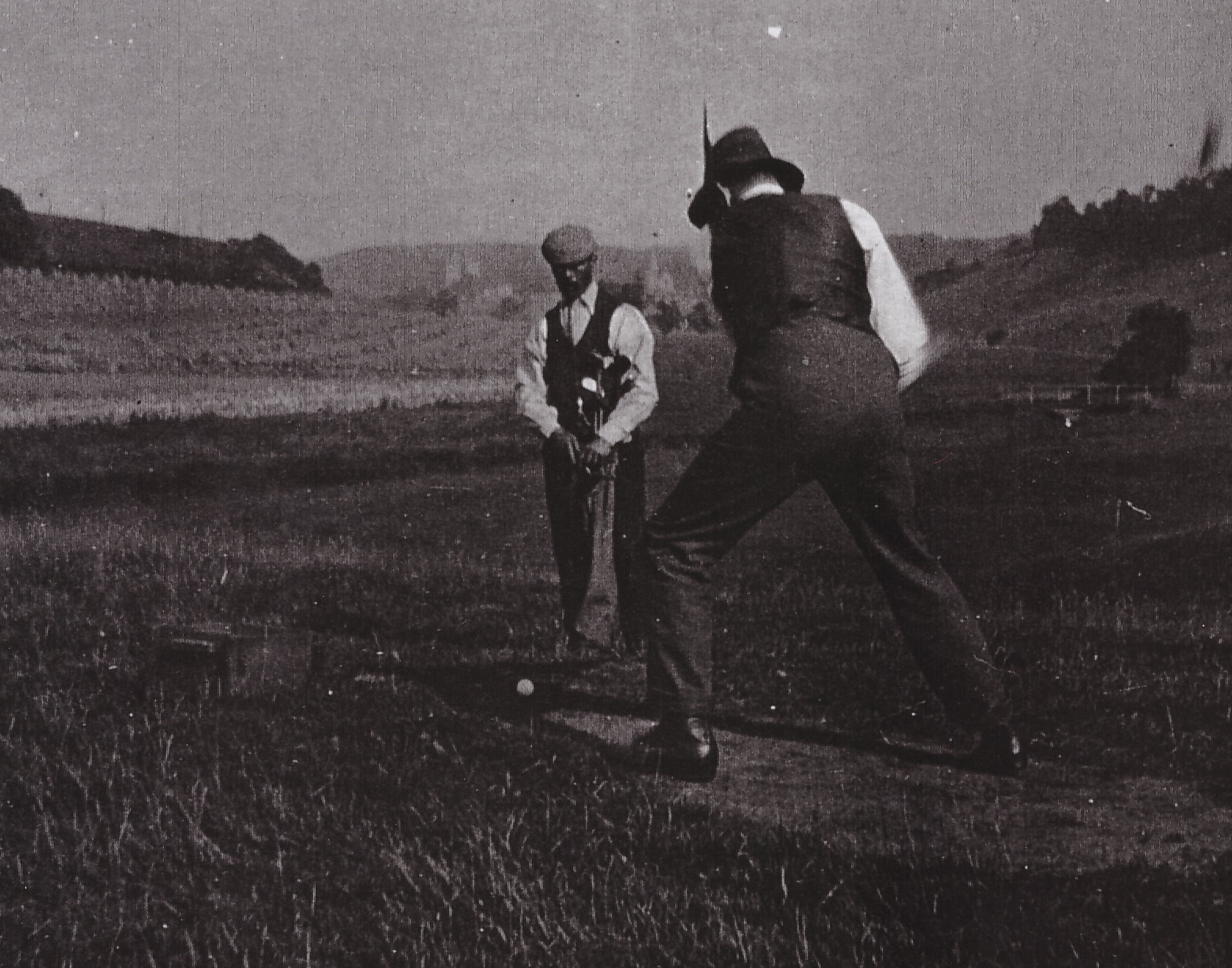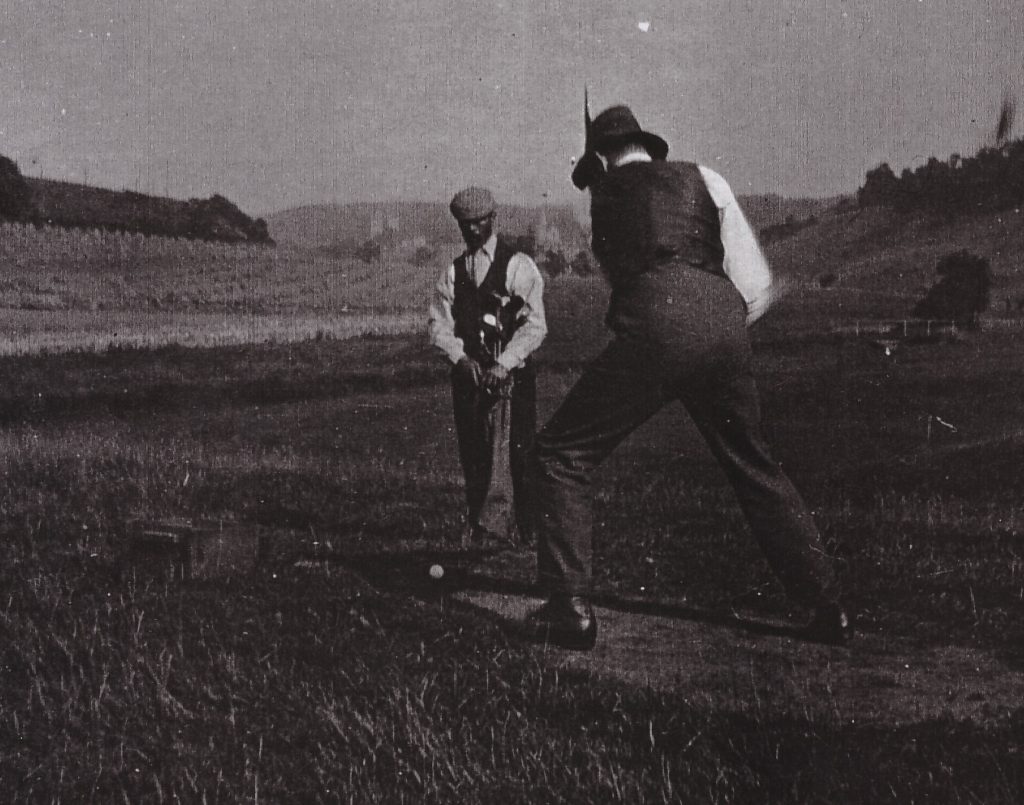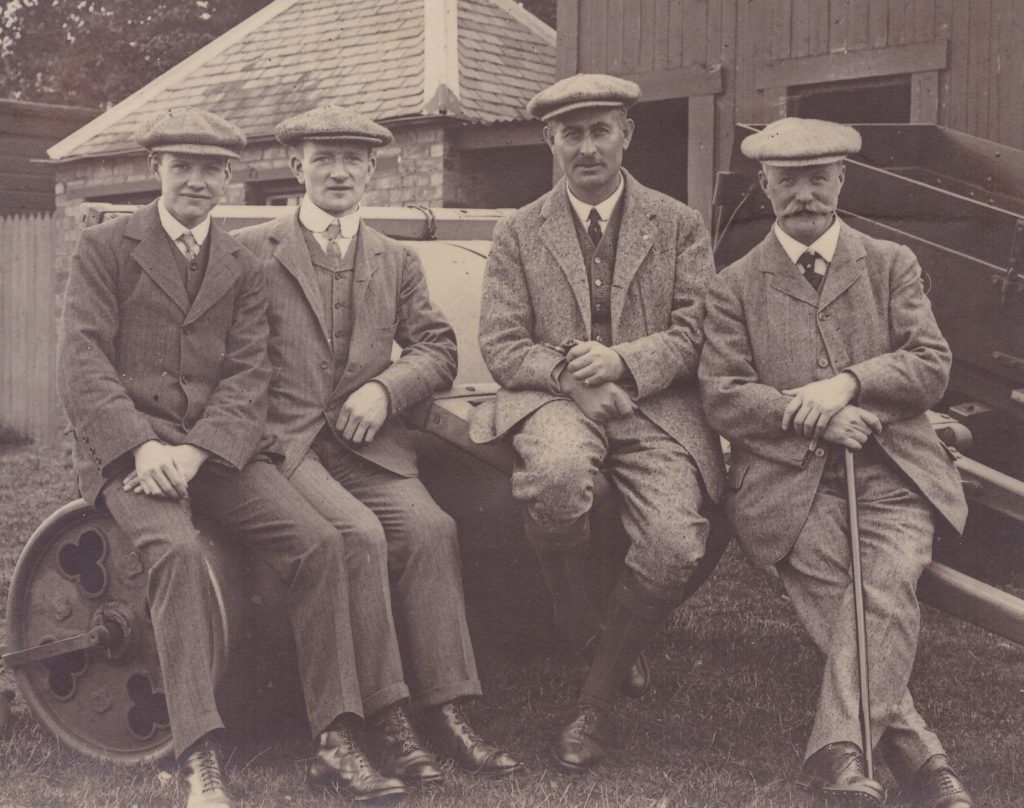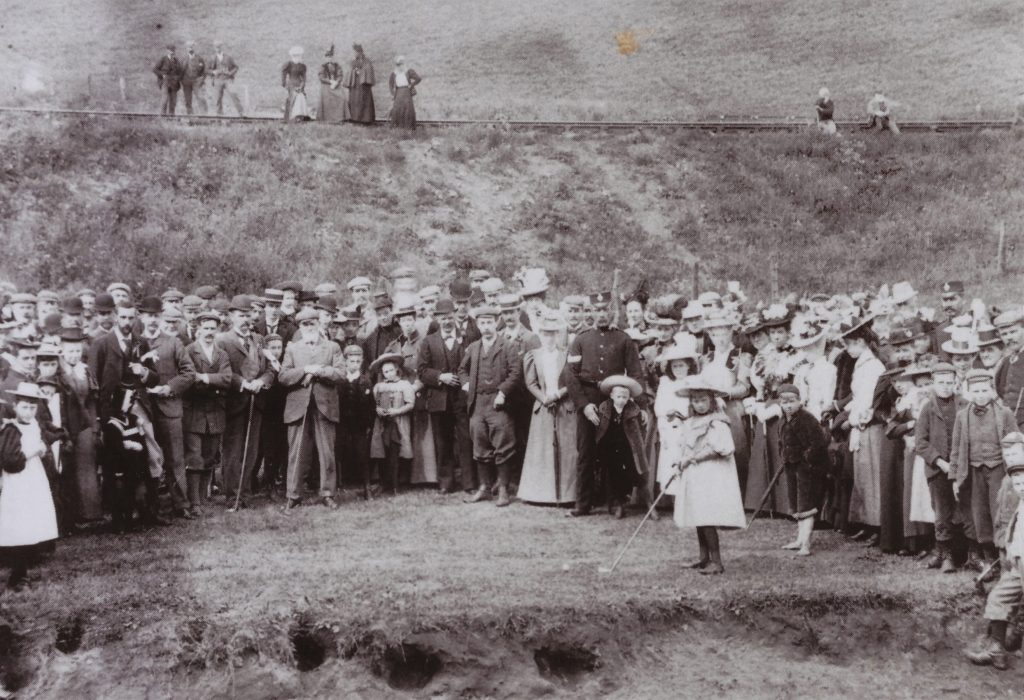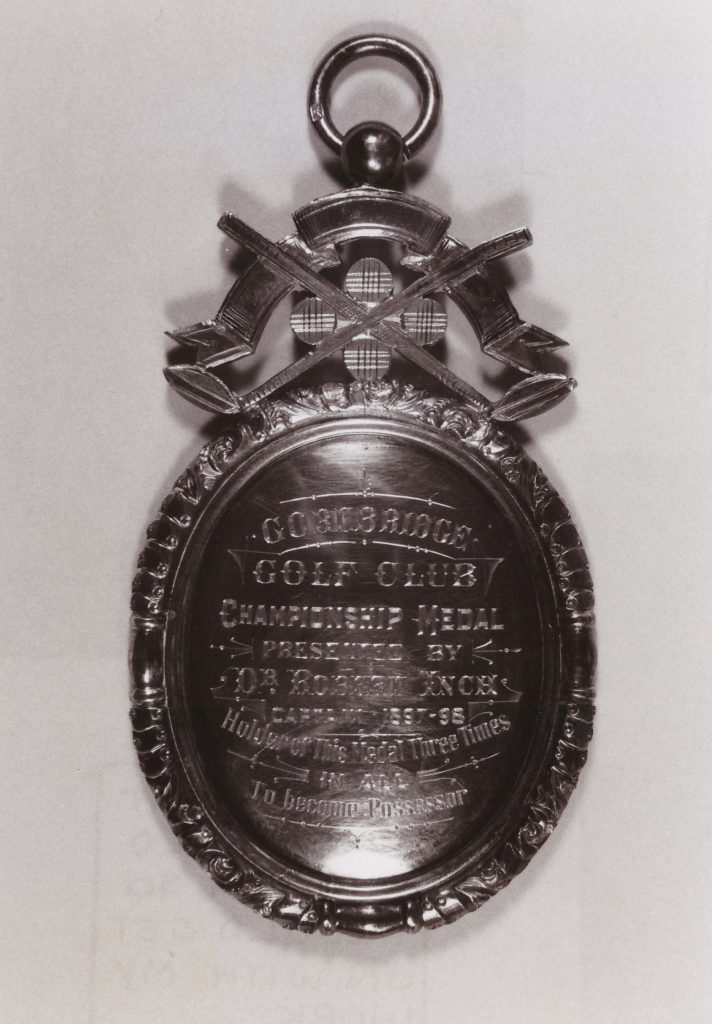[This article is from the opening chapter of Jim Forson’s 2013 research project: ‘Golfing by the Gore: A history of Gorebridge golf Club 1896-1918’]
Introduction
The last two decades of the nineteenth century was a period of industrial growth in Scotland which was accompanied by a rapid increase in the urbanisation of the population. This population increase, associated with industrial prosperity provided a new, relatively well off, middle class, who were reasonably mobile as a result of the expanding railway network. It is not surprising that leisure activities, such as golf, also underwent considerable growth. During the last decade of the nineteenth century, twenty-seven new golf courses (nine of which were 9 holes) opened in the Lothians & Borders Region. It is not surprising that Upper Midlothian wanted a piece of the action!
This small paragraph appeared in the Dalkeith Advertiser of April 2nd, 1896:
It will be noticed that a public meeting is called to be held tonight with regard to this proposed golf course. I understand that the experts who have examined the ground report that the course would be an exceptionally attractive one; and as terms have been arranged with regard to the acquisition of the ground, it looks as if the golf course would be the first of the schemes for recreative purposes which will be carried into effect. If a sufficient number of intending members appear at the meeting, or send their names to the secretary, Mr J G Patterson, the formation of the course will be begun at once, and play may be expected in a few weeks. This looks like business, and it is hoped that there will be crowds of intending members, so that the scheme might get a good ‘shove-off’.
You would be forgiven for thinking that this intimation referred to the Gorebridge Golf Club. In fact, the meeting was called in Dalkeith regarding the formation of a ‘Dalkeith & District Golf Club’.
The Dalkeith Advertiser had stirred up a bit of a ‘stooshie’ by printing the following piece immediately above the paragraph on the proposed golf course.
How easily some communities obtain privileges besides others. Here in Gorebridge for instance. By the generosity of Mr Dundas of Arniston, who by-the-by has no connection with the village further than being a neighbour, Gorebridge being on the Vogrie Estate, the community has been provided with a reading room, a recreation ground, a bowling green, a public hall, and now, almost as soon as the wish has been expressed, Mr Dundas has given a quoiting pitch for the use of the villagers. Such abundant means of recreation and enjoyment may well make neighbours of Gorebridge envious.
But while perhaps a little envious, we do not begrudge Gorebridge her privileges, and in a short time Dalkeith will be certain to be upsides with her. Once we have our public park and our bowling green and quoiting pitch we will not be so ill off; but we will also have another, and some think better, recreation ground than any of these – a golf course.
The response for Gorebridge was swift and two weeks later on April 16th, a small paragraph appeared in the Dalkeith Advertiser:
Gorebridge is not going to be beat by Dalkeith so far as a golf course is concerned, and without much ‘preliminaries’ they have embarked on a scheme which, if it is carried to a successful termination, and there is no reason why it should not, will put them upsides with their biggest neighbour.
Proposal
In the same edition of the paper there appeared a report of a meeting held in Newbyres Hall, Gorebridge on Monday 13th April 1896:
Proposed Golf Course – A meeting called by Mr Blaik (who had been waited upon by a deputation asking him to do so) was held in the Newbyres Hall on Monday evening to consider a proposal to secure a golf course for Gorebridge and District. Major Dundas presided over about thirty gentlemen representatives od Gorebridge and District. It was agreed to engage a professional to go over a piece of ground at Catcune, near Fushie Station, at present occupied by Mrs Wilson, Torcraik; and Mr Pendreigh, Catcune; to report on its suitability for a course. A committee consisting of Mr Blaik (convener), Mr Geo. Pendreigh, Catcune; Dr Inch, Mr Kelley, Newlandrig; and Mr W McNab, Gorebridge; were appointed to go into the matter and report to a future meeting.
It is significant that the meeting was attended by ‘gentlemen’ of the district and this signalled straight away that working men would be excluded from membership (certainly initially). It would be fair to say that the proposed sight for the course, in the Borthwick Valley, be considered fairly remote although it had the benefit of Fushiebridge Station a short distance away and this would be of great assistance to members/visitors travelling from outside the district. Nevertheless, the committee proceeded with their task at admirable speed and were able to report back to a further meeting at the end of April.
An extract from the ‘Interim Committee Report – April 1896’ from that meeting follows:
The proposed golf course is situated about a mile to the South of Gorebridge, and within easy access of Gorebridge and Fushiebridge stations, it lies in the beautiful valley of Borthwick. It is flanked on one side by the North British Railway, and on the other by a nicely wooded fringe of the Middleton estate (Black Bog Wood), while at the southern end Borthwick Castle adds beauty to the scene. Peter Lees of Barnton has been engaged to assess the ground and propose a nine-hole layout, which is all that can be obtained from the available ground. In his view he has stated it will be one of the finest and most natural sporting courses in Scotland. The first hole as planned will take good play to negotiate. Two obstacles will have to be cleared, the burn and a wall about three feet high. The second is a splendid hole and will have a grandly situated putting green in a hollow. This will be a double green with the eighth coming home. The third is a short hole, but a very tricky one, as the burn is immediately in front of the green and will be surrounded by whins. The fourth is a pretty long hole, and the burn forms a hazard from the tee until the green is reached.
The fifth will be the longest hole on the course, and hazards abound in the rushes. The sixth is an easy hole, but the approach will have to be nicely judged as the burn is behind the green. The seventh has the burn immediately in front of the tee, and the eighth, as previously mentioned shares the green with number two. The last, the ninth, is a fine sporting hole. The burn, properly called the Gore Water, runs right up the course all the way, then a stone wall has again to be crossed. The committee has not yet obtained the permission of the proprietors, who are present abroad, as also the farming and shooting tenants.
Nature of the Course and Challenges
The beautiful Borthwick Valley lies in Upper Midlothian and although only around 500 feet above sea level, the winter weather is more severe and can restrict winter play quite considerably. The underlying geology of the area is of two types of Sedimentary Rock; to the north towards the Southern Upland Fault, Carboniferous, consisting of Shales, Sandstones, Limestone and Coal; to the south, Cambrian, Ordovician and Silurian, consisting of Shales, Sandstones and Limestone. The Borthwick Valley is a good example of river terraces and flood plain with rounded slopes on either side caused by a glacial and post glacial erosion as little as ten thousand years ago. It would be fair to describe the chosen sight as challenging with water draining down the valley siders to the Gore Water.
The adjacent North British Railway ‘Waverley Line’ was a great asset to the club. The committee would quickly realise that the local catchment area was insufficient to maintain a sustainable membership and look towards Edinburgh to attract golfers to supplement the membership. Fushiebridge Station was only a matter of 300 yards from the course and the train was the principle mode of transport for players out with the immediate area to reach the course.
Motor transport was still relatively rare and was the preserve of the well off. Bradshaw’s Guide gives a journey time of 37 minutes from Edinburgh Waverley to Fushiebridge with an extra five minutes added if the journey started at Leith. Fares varied from 1/1d to 1/7d depending on the class of the carriage. The journey time from Galashiels to Fushiebridge was 57 minutes with fares from 2/6d to 4/-. The trip between Gorebridge and Fushiebridge by train only took 3 minutes with a third-class fare costing 1d.
It appears the committee had set themselves the target of beating Dalkeith to be the first to open a golf course. Unfortunately, Gorebridge could go no further until the proprietors and tenants of the land, Catcune Farm being part of Vogrie Estate and Torcraik Farm being part of Middleton Estate, returned from abroad and negotiations could begin.
The Dalkeith Committee had no such problems and the ‘Dalkeith and District’ golf club was officially opened on May 13th, 1896 as the Dalkeith/Newbattle Golf Club. The Dalkeith Advertiser of July 23rd, 1896 printed a progress report on the proposed golf course at Fushiebridge:
Progress is being made in the negotiations for the new golf course at Fushiebridge. It is expected that a beginning to the course will be made forthwith. The rent has not been definitely fixed yet but it is expected it will not amount to more than £20 per annum.
However, no start was made to the golf course ‘forthwith;’ and it was nearly a year later before agreement was reached between the various parties.
Progress and Formation
On Thursday, May 6th 1897 the following article appeared in the Dalkeith Advertiser:
The proposed golf course – as the result of efforts put forth by Captain Dundas, Councillor Blaik and other gentlemen in the upper district of Mid-Lothian, a golf course is at last to be obtained for the convenience of players in that district. A start was made on the new course on Monday when the various putting greens etc were pegged off by Mr Lees of Barnton, who was accompanied round the course by Captain Dundas and Mr T J Ramsay. A meeting was held in the evening in Newbyres Hall with Mr J Cook in the chair. The following list of office bearers were appointed
Honorary President – Captain Dundas
Honorary Vice Presidents – Messrs W C Weir, G Pendreigh, J Y Trotter-Cranston
Captain – Dr Robert Inch
Vice Captain – Mr A Wilson Spalding
Honorary Treasurers – Captain Dundas, Mr J Cook
Treasurer – Mr J Blaik JP
Honorary Secretary – Mr W G McNab
Executive Council – Messrs T J Ramsay, W B Torrance, J Malcolm, A Duncan, J Wilson, Rev W Waddell
On Tuesday, members of the committee as lately appointed, went over the ground which has been selected – about a mile south of Gorebridge. The ground is admirably adapted, not being so flat as most inland courses, and there are hazards of various kinds in the shape of whins, a burn and stone walls. It is hoped that it will be possible to commence play early in June. Already a large number of players have come forward, and it is expected that over a hundred gentlemen, beside ladies and youths, will have joined by the time the course is open. The ground is conveniently situated within easy access of Fushiebridge and Gorebridge stations.
Peter Lees who was brought in to lay out the holes at Fushiebridge, was a well known and respected greenkeeper in the Lothians. He was originally appointed to lay out the course at Braid Hills in 1889 and subsequently moved to Mortonhall Golf Club in 1892 and then to the Edinburgh Burgess Golf Club. He could be termed as one of the early golf course architects, a function normally carried out at the time by the better known professional golfers of the day.
Good progress was made with the construction of the golf course, despite having a relatively challenging site, and with a considerable number of members having already joined the club, the committee in buoyant mood set the formal opening date of the new course for Saturday June 19th 1897. The annual subscription was set at £1-1/- with an entry fee of 10/6d. Although the larger part of the leased ground lay to the south of the Gore Water, much of this land was unusable due to the severe slopes, Gore bushes and boggy areas. As a result, the nine hole course was laid out with the Gore Water coming into play at almost every hole. Most of the golf course lay on the 2552 acre Middleton Hall Estate of Edward Moss, whish he purchased in 1892 from William Richie. Moss did not take up residency at Middleton Hall immediately, due to his busy theatrical business, and when in Edinburgh stayed in his house at no. 8 Minto Street with the estate leased to Mr W C Weir.
Opening
On 24th June 1897, the Dalkeith Advertiser reported on the official opening of the course:
On Saturday afternoon the new golf course in connection with the Gorebridge Club was formally opened. As previously stated the course is situated a short distance from Fushiebridge Station. The day was an ideal one, and a large number of ladies and gentlemen were present at the opening ceremony…
At three o’clock Mr Blaik introduced Major Dundas who was to declare the course open. In doing so he said that the committee had had considerable trouble in getting the course made, but he was sure that in some time it would be, if not the very best, one of the most sporting courses in existence. He had to introduce one to declare the course open, who had taken a very deep and enthusiastic interest in the club. He believed the committee had made aa most excellent choice in asking Major Dundas to perform the ceremony. Major Dundas then called on Miss Eva Inch, daughter of Dr Inch, to play off the first ball, and, on behalf of the Fourth Rubber Company, presented her with a silver mounted cleek. Barry, the greenkeeper, the teed the ball, and Miss Eva made a very satisfactory drive. Major Dundas after declared the course open, and expressed the gratitude of the members to the proprietors and tenants on whose grounds the course had been formed, and he must especially single out Mr George Pendreigh, to whom they owed a deep debt of gratitude (applause). He urged all of those who were present to enter their names in the secretary’s books, and if they did that the club was sure to prosper. On the motion of Dr Inch the Major was thanked for his services, and afterwards a photograph of the company was taken by Mr James Patrick, of Messrs John Patrick & Son, Edinburgh. Several foursomes were afterwards formed, and a round of the course made.
The club officials had hoped that Mr Leslie Balfour and several other crack amateurs of the day would attend the opening ceremony and play the first round on the new course but unfortunately this did not transpire.
The general opinion of the golfers present at the opening ceremony was that the course was indeed a very sporting one – a little too much so for beginners – but should in time prove to be very attractive to the ‘knights of the cleek’. The frequent use of the term sporting to describe the course was really a euphemism for extremely challenging. Facilities were fairly basic with only a small hut beside the first tee combining as a clubhouse and green keepers shed.
First Year and Difficulties
By August, membership had reached 70 and the course was largely being taken advantage of, with a few strangers visiting the club to sample the new course. A most unusual offer was put to the committee in August 1897. In order to make the course still more attractive the committee accepted the services of 25 working men who had offered to cut out a number of whins, bushes and other obstructions, during their spare time in the evenings and weekends. The committee felt that upon the completion of this work their course would be the best in the district. This offer from the working men was all the more strange as they were excluded from membership of the club at the time. The golf club settled down to the business of playing golf, initially with a number of challenging matches. The first match was played between the captain’s team and the vice-captain’s team. It was reported that their had been a fairish turn out of
members although the standard of golf was not what it ought have been. The vice-captain’s team won by seven holes. Another of the early matches was played between Messrs W Torrance and D Cook, and Messrs W Spalding and A Duncan, the challenge being for a box of golf balls. The tussle resulted in a win for Torrance and Cook by five holes.
The club played its first formal competition on Saturday 2nd October 1897, for the Inch Medal. The Inch Medal, or the Inch Championship Medal as it became known, was presented to the club by Dr Inch, the first captain. 32 members competed for the medal with the scoring high across the board. The winner was J Geddes, with a score of 106 for two circuits of the nine-hole course.
The short first season of the course was now drawing to a close as far as the golf was concerned. The membership had fallen well short of the hoped for 100 members – presenting the council with a financial problem. Their solution was to organise a concert in aid of club funds. The concert was held on the evening of Monday 25th October 1897, in Newbyres Hall. The president of the club, Captain Dundas, occupied the chair whilst accompanying him were Dr Inch, the captain and Mr A Wilson Spalding, the vice-captain. Despite being described as one of the most successful ever concerts held in Gorebridge, the finances of the club remained in a perilous state.
Mr George Pendriegh of Catcune, presented a Gold Medal to the club for competition, henceforth to be known as the Pendreigh Monthly Medal. This was followed shortly afterwards by the presentation of a Gold Badge to the club by Mr Thomas MacNab, Leith, for competition amongst the winners of the Pendreigh Monthly Medal. It was hoped that the incentive of more club competitions would encourage new players to join the club.
With the first year of the club coming to an end, many problems still existed for the new club. Despite having the local ‘heavyweights’ such as the Dundas family, J Y Trotter Cranstoun, and Mr W C Weir of Middleton on board, membership remained well below the hoped for 100 members. Finances remained a continual problem and the course, although continually improving, was regularly heavy and only really enjoyable to better, more experienced golfers.

